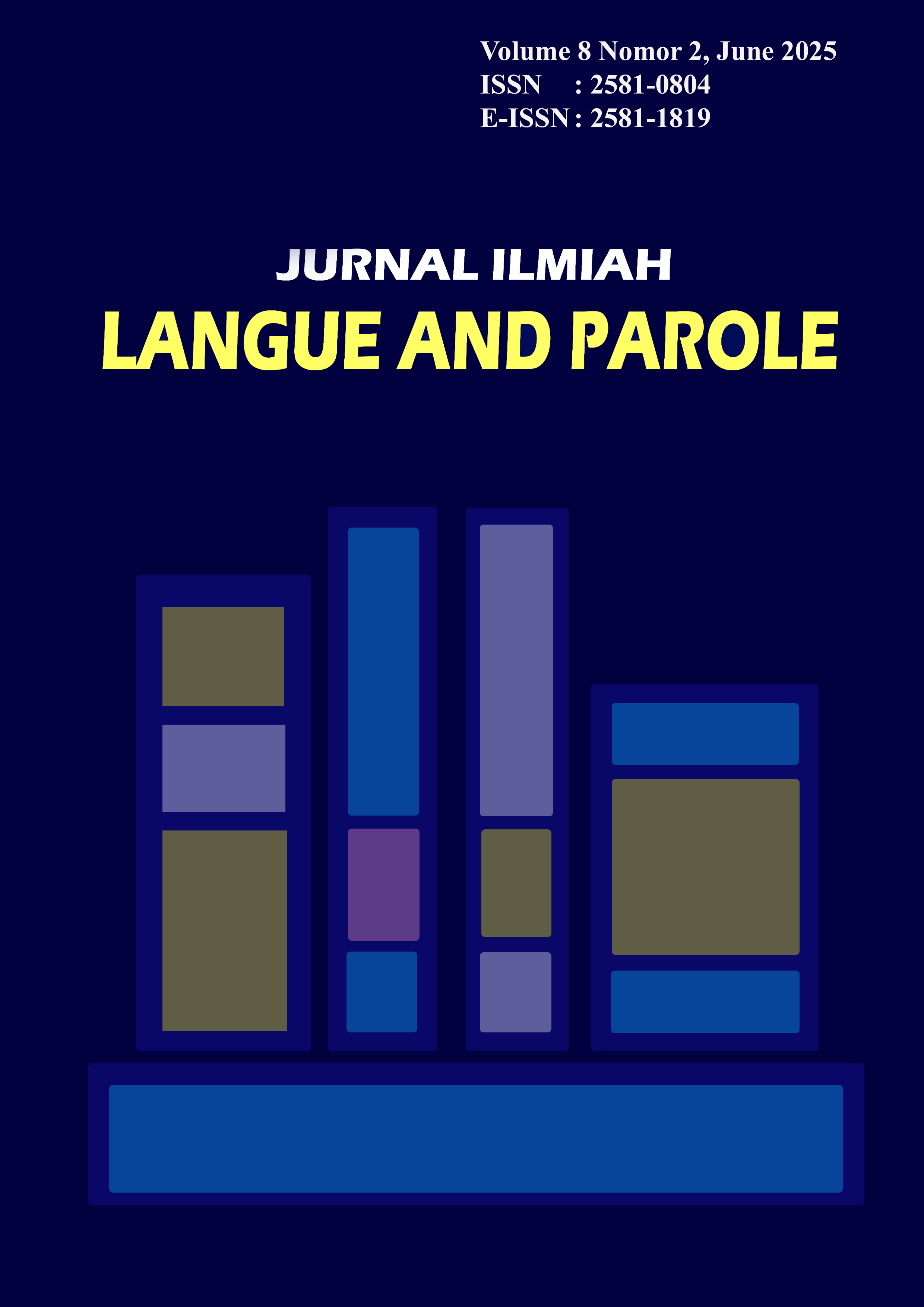Randai as Traditional Minangkabau Culture In Padang Pariaman: A Semiotic Analysis
DOI:
https://doi.org/10.36057/jilp.v8i2.722Keywords:
Randai, Semiotics, Linguistic, SignsAbstract
This research discusses linguistics signs in randai art originating from west sumatera, randai is a traditional minangkabau drama or theater performance art which is rich in art, noble values and linguistic element in each element of randai, namely, music, drama, gurindam, galombng or dance and silek. Linguistics elements that have meaning in each element are visualized in legaran movements in the form of circular patterns which function as a form of change in time between one scene and the next scene. This research aims to analyze and describe the lingual signs and body language signs found in randai elements and function in the context of minangkabau culture.The research method used is descriptive qualitative, with data collected through field observations, interviews, documentation in the form of videos and photos with art pioneers, members of legaran randai. Then the researcher conducted a literature study using Saussure and Barthes semiotics theory. The results of this research show that randai is a complex performing art that combines elements of movement or silek, music, dialogue and singing. The randai movement has distinctive characteristics that reflect the noble values and philosophy of Minangkabau culture, namely leadership and mutual cooperation and a sense of unity. Randai also has a function as a medium for education, entertainment that conveys moral messages or social criticism as well as a form of local minangkabau wisdom.
Downloads
References
[1]Al Umman, Khoirul Zaman. (2015). Ferdinand De Saussure: Structuralism and his role in modern linguistics. Lisanudhad: Jurnal Bahasa, Pembelajaran, dan Sastra Arab, 2(1).
[2]Danesi, Marcel. (2004). Messages, signs, and meanings:. Toronto,ontario: Canadian Scholars' press.
[3]El Riza, Sayuti., and Sayuti, Suminto, A. (2019). Symbolical Meaning of Langen Puspitosari Dance in Building Students Character in Suryokencono Arts Association. In International conference on Art and Arts Education (ICAAE 2018). Atlantis Press.
[4]Hadijah, Lailan. (2019). Local Wisdom in Minangkabau Cultural Tradition of Randai. KnE Social Sciences, 399-411.
[5]Hart, Richard E. (2004). Sussane K Langer, 1895-1985. The blackwell Guide to American Philosophy, 2004.
[6]Lune, Howard, and Bruce L. Berg. (2017) Qualitative research methods for the social sciences. Pearson
[7]Maryelliwati, M., Rahmat, W., and Anwar, K. (2019). Maintenance of Minangkabau Culture in Randai at Mungka Based on Education And Tourism. Magista Andalusia: Jurnal Ilmu Sastra, 1(2).Muryasari, D., and Retnowati, T.H. (2020). Construction Trajectory of Bekakak Tradition in Gamping:Analytical Study of Pierce Semiotics. In 3rd International Conference on Arts and Arts Education (ICCAE 2019. Atlantis Press.
[8]Paramarta, I. Made Suta. (2022). Balinese language on the street signs in Singaraja Town, Bali: A Linguistic Landscape analysis. Ranah Jurnal Kajian Bahasa. 11(1), 120-129.
[9]Piliang, Yasraf Amir. (2004). Semiotika teks: Sebuah Pendekatan Analisis Teks.
Mediator: Jurnal Komunikasi.
[10]Priventa, H., and Noor, R. (2020). The
Meaning of Tolaki, Minangkabau, and
Timor Cultural Symbol in Three Nusantara Folklores: Oheo, Kaba Malin Deman, and Tujuh Bidadari. Selokdenoa: Jurnal Pendidikan Bahasa dan Sastra Indonesia.
[11]Rahardjo, Muhammad. (2011). Metode Pengumpulan Data Penelitian Kualitatif
[12]Sembiring, H. N., Sitorus, W., and Siahaan, H. V. F. (2021). Symbolism In The Dance of Karonese Traditional Wedding Ceremony. Jurnal Littera: Fakultas Sastra Darma Agung.
[13]Siregar, Iskandarsyah. (2022). Semiotics Analysis in The Betawi Traditional Wedding “Palang Pintu”: The Study of Semiotics Roland Barthes. International Journal of Linguistics Studies.
[14]Stawarska, Beata. (2014). Saussure's Philosophy of Language as Phenomenology. New york: Oxford University Press.
[15]Vanderstoep, Scott W., and Johnston, D. D. (2009). Research methods for everyday life blending qualitative and quantitative approaches. San Fransisco,CA: Jossey-Bass.
[16]Yuliza, Fresti. (2022). Makna Tari Kontemporer Barangan Karya Otniel Tasman: Suatu tinjauan Semiotika Tari. Bercadik: Jurnal Pengkajian dan Penciptaan Seni.
Downloads
Published
How to Cite
Issue
Section
License
Copyright (c) 2025 Jurnal Ilmiah Langue and Parole

This work is licensed under a Creative Commons Attribution-NonCommercial-ShareAlike 4.0 International License.








